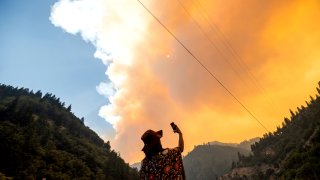
A rapidly growing wildfire south of Lake Tahoe forced the evacuation of a mountain town and the cancellation of an extreme bike ride through the Sierra Nevada, leaving thousands of riders and spectators stranded Saturday and rushing to flee the area.
The Tamarack Fire, which was sparked by lightning on July 4, exploded overnight to about 10 square miles and was burning six miles south of Markleeville, a small town close to the California-Nevada state line. It has destroyed at least 3 structures, authorities said. A notice posted on the 103-mile Death Ride’s website said several communities in the area had been evacuated and ordered all riders to also evacuate immediately.
Kelli Pennington and her family were camping near the town Friday so her husband could participate in his ninth ride when they were told to pack up and leave. They had been watching smoke develop over the course of the day, but were caught off guard by the fire’s quick spread.
“It happened so fast,” Pennington said. “We left our tents, hammock and some foods, but we got most of our things, shoved our two kids in the car and left.”
Get top local stories in Southern California delivered to you every morning. >Sign up for NBC LA's News Headlines newsletter.
Saturday’s ride was supposed to mark the 40th anniversary of the Death Ride, which attracts thousands of cyclists to the region each year to ride through three mountain passes in the so-called California Alps.
Afternoon winds blowing at 20 to 30 mph fanned the flames as they chewed through bone-dry timber and brush.
Meanwhile, the largest wildfire in the U.S. — burning in southern Oregon — grew significantly overnight as dry and windy conditions took hold in the area, but containment of the inferno more than tripled as firefighters began to gain more control along its western flank, authorities said Saturday. The fire was still burning rapidly and dangerously along its southern and eastern flanks, however, and authorities expanded evacuations in a largely rural area of lakes and wildlife refuges.
U.S. & World
News from around the country and around the globe
A red flag weather warning, signifying strong winds and hot, dry conditions, remained in effect through Saturday evening.
“This fire is large and moving so fast, every day it progresses 4 to 5 miles,” said Incident Commander Joe Hassel. “One of the many challenges that our firefighters face every day is working in new country that can present new hazards all the time.”
Extremely dry conditions and heat waves tied to climate change have swept the region, making wildfires harder to fight. Climate change has made the West much warmer and drier in the past 30 years and will continue to make weather more extreme and wildfires more frequent and destructive.
In southern Oregon, fire crews have dealt with dangerous and extreme fire conditions, including massive “fire clouds” that rise up to 6 miles above the blaze. The Bootleg Fire has destroyed at least 67 homes and 117 outbuildings.
The conflagration has forced 2,000 people to evacuate and is threatening 5,000 buildings, including homes and smaller structures in a rural area just north of the California border. Containment of the fire more than tripled Saturday thanks to better conditions on the western edge of the fire that allowed crews to drop water and fire retardant on flames and secure fire breaks.
The National Weather Service warned of possible thunderstorms stretching from the California coast to northern Montana on Sunday and that “new lightning ignitions” are likely because of extremely dry fuels across the West.
Firefighters said in July they were facing conditions more typical of late summer or fall.
The Bootleg Fire grew to 439 square miles Saturday and was just one of numerous fires burning across the drought-stricken U.S. West, as new fires popped up or grew rapidly in Oregon and California.
There were 70 active large fires and complexes of multiple fires that have burned nearly 1,659 square miles in the U.S., the National Interagency Fire Center said. The U.S. Forest Service said at least 16 major fires were burning in the Pacific Northwest alone.
A fire in the mountains of northeast Oregon was also growing rapidly and was 17 square miles in size on Saturday. The Elbow Creek fire started Thursday and has prompted evacuations in several small, rural communities around the Grande Ronde River about 30 miles southeast of Walla Walla, Washington.
Oregon Gov. Kate Brown invoked the Emergency Conflagration Act to mobilize more firefighters and equipment to help fight that fire.
The Dixie Fire, near the 2018 site of the deadliest fire in the U.S. in recent memory, was 5% contained and covered 39 square miles Saturday. The fire was in the Feather River Canyon, northeast of the town of Paradise, California, and survivors of that horrific fire that killed 85 people watched warily as the new blaze burned.
Officials ordered the evacuation of a wilderness recreation area and kept in place a warning for residents of the tiny communities of Pulga and east Concow to be ready to leave.
“We’re prepared,” said Mike Garappo, a retired military veteran. “We’ve dealt with fires living in the mountains forever. We know there’s a chance it may not hit here, but we’re ready to go in case.”



